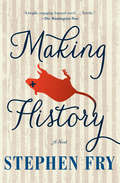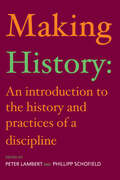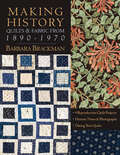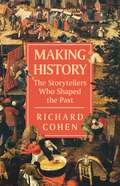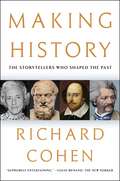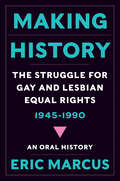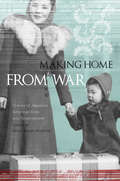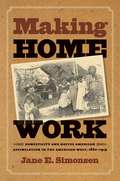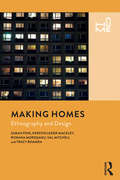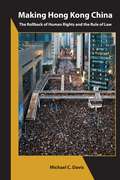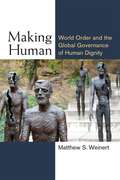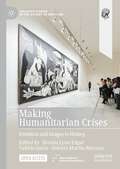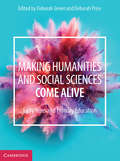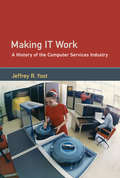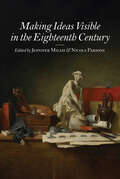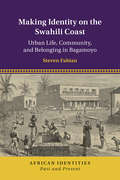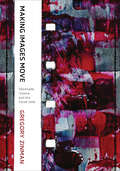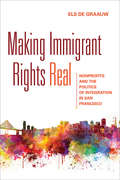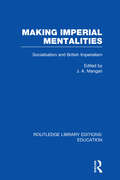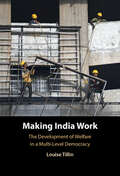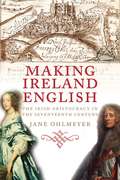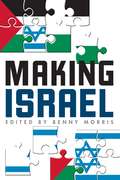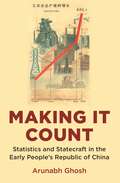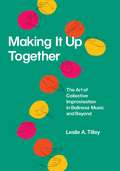- Table View
- List View
Making History: A Novel
by Stephen FryStephen Fry tackles alternate history, asking: What if Hitler had never been born? Michael Young is a graduate student at Cambridge who is completing his dissertation on the early life of Adolf Hitler. Leo Zuckerman is an aging German physicist and Holocaust survivor. Together they idealistically embark on an experiment to change the course of history. And with their success is launched a brave new world that is in some ways better than ours--but in most ways even worse. Fry's sci-fi-tinged experiment in history makes for an ambitious and deeply affecting novel.From the Trade Paperback edition.
Making History: An Introduction to the History and Practices of a Discipline
by Peter Lambert Phillipp SchofieldMaking History offers a fresh perspective on the study of the past. It is an exhaustive exploration of the practice of history, historical traditions and the theories that surround them. Discussing the development and growth of history as a discipline and of the profession of the historian, the book encompasses a huge diversity of influences, organized around the following themes: the professionalization of the discipline the most significant movements in historical scholarship in the last century, including the Annales School the increasing interdisciplinary trends in scholarship theory in historical practice including Marxism, post-modernism and gender history historical practice outside the academy. The volume offers a coherent set of chapters to support undergraduates, postgraduates and others interested in the historical processes that have shaped the discipline of history.
Making History: Quilts & Fabric from 1890–1970
by Barbara BrackmanThis wide-ranging book shows how to create quilts with an authentic antique look, collect period textiles, while revealing the history of American fabrics. Learn the fascinating true story of fabrics in America and make your own period quilts with this comprehensive guide to fabrics and their influence on American quilts, from the machine age to the atomic age. From quilt historian Barbara Brackman, author of America's Printed Fabrics 1770–1890,Making History not only includes 9 quilt projects inspired by vintage quilt designs and fabrics, but is packed with historic photos, stories, and insights into the role of fabrics in everyday life.
Making History: The Storytellers Who Shaped the Past
by Richard CohenMAKING HISTORY is an epic exploration of who writes about the past and how the biases of certain storytellers - whether Julius Caesar, William Shakespeare or Simon Schama - continue to influence our ideas about history (and about who we are) today. In this authoritative and entertaining book, Richard Cohen reveals how professional historians and other equally significant witnesses (such as the writers of the Bible, major novelists, dramatists, journalists and political propagandists) influence what become the accepted records of human experience. Is there, he asks, even such a thing as 'objective' history? The depth of Cohen's inquiry and the delight he takes in his subjects includes the practitioners of what he calls 'Bad History,' those thieves of history who twist reality to glorify themselves and conceal their or their country's behaviour. Cohen investigates the published works and private utterances of our greatest historical thinkers to discover the agendas that informed their views of the world, and which in so many ways have informed ours. From the origins of history-writing, when such an idea seemed itself revolutionary, through to television and the digital age, MAKING HISTORY abounds in captivating figures brought to vivid life, from Thucydides and Tacitus to Voltaire and Gibbon, from Winston Churchill to Mary Beard. Rich in character, complex truths and surprising anecdotes, the result is a unique exploration of both the aims and craft of history-making. It will lead us to think anew about our past and ourselves.
Making History: The Storytellers Who Shaped the Past
by Richard CohenA &“supremely entertaining&” (The New Yorker) exploration of who gets to record the world&’s history—from Julius Caesar to William Shakespeare to Ken Burns—and how their biases influence our understanding about the past. There are many stories we can spin about previous ages, but which accounts get told? And by whom? Is there even such a thing as &“objective&” history? In this &“witty, wise, and elegant&” (The Spectator), book, Richard Cohen reveals how professional historians and other equally significant witnesses, such as the writers of the Bible, novelists, and political propagandists, influence what becomes the accepted record. Cohen argues, for example, that some historians are practitioners of &“Bad History&” and twist reality to glorify themselves or their country. &“Scholarly, lively, quotable, up-to-date, and fun&” (Hilary Mantel, author of the bestselling Thomas Cromwell trilogy), Making History investigates the published works and private utterances of our greatest chroniclers to discover the agendas that informed their—and our—views of the world. From the origins of history writing, when such an activity itself seemed revolutionary, through to television and the digital age, Cohen brings captivating figures to vivid light, from Thucydides and Tacitus to Voltaire and Gibbon, Winston Churchill and Henry Louis Gates. Rich in complex truths and surprising anecdotes, the result is a revealing exploration of both the aims and art of history-making, one that will lead us to rethink how we learn about our past and about ourselves.
Making History: The Struggle for Gay and Lesbian Equal Rights, 1945–1990
by Eric MarcusWhen Making History was first published in 1992, the acclaimed oral historian Studs Terkel called it, “One of the definitive works on gay life.” Novelist Armistead Maupin said that author “Eric Marcus not only writes with grace and clarity but makes it look so easy—the ultimate measure of historian and novelist alike.” Now, for the first time, the original complete edition of Making History is available in e-book. Through his engaging oral histories, Eric Marcus traces the unfolding of LGBTQ civil rights effort from a group of small, independent underground organizations and publications into a national movement, covering the years from 1945 to 1990. Here are the stories of its remarkable pioneers: a diverse group of nearly fifty Americans, who hail from all corners of the nation. From the period in history when homosexuals were routinely beaten by police to the day when gay rights leaders were first invited to the White House, Making History is the story of an against-all-odds struggle that has succeeded in bringing about changes in American society that were once unimaginable.
Making Home From War: Stories of Japanese American Exile and Resettlement
by Brian DempsterMany books have chronicled the experience of Japanese Americans in the early days of World War II, when over 120,000 persons of Japanese ancestry, two-thirds of whom were American citizens, were taken from their homes along the West Coast and imprisoned in concentration camps. When they were finally allowed to leave, a new challenge faced them—how do you resume a life so interrupted? For most, going home meant learning to live in a hostile, racist environment. Some returned to find they had lost their homes and had little choice but to bide their time in transitional housing, including community halls, churches, housing projects, and tent camps. Their employment options were also limited; they often worked as domestics, dishwashers, and field laborers to help support their families. The effects of these experiences reverberate to this day, and Making Home from War reaches into the past, melds together what was once hidden, and tells the often neglected or hushed story of what happened after the war. <P><P>With honesty and an eye for detail, Making Home from War is the long-awaited sequel to the award-winning From Our Side of the Fence. Written by twelve Japanese American elders who gathered regularly at the Japanese Cultural and Community Center of Northern California, Making Home from War is a collection of stories about their exodus from concentration camps into a world that in a few short years had drastically changed. In order to survive, they found the resilience they needed in the form of community, and gathered reserves of strength from family and friends. Through a spectrum of conflicting and rich emotions, Making Home from War demonstrates the depth of human resolve and faith during a time of devastating upheaval.
Making Home Work
by Jane E. SimonsenDuring the westward expansion of America, white middle-class ideals of home and domestic work were used to measure differences between white and Native American women. Yet the vision of America as "home" was more than a metaphor for women's stake in the process of conquest--it took deliberate work to create and uphold. Treating white and indigenous women's struggles as part of the same history, Jane E. Simonsen argues that as both cultural workers and domestic laborers insisted upon the value of their work to "civilization," they exposed the inequalities integral to both the nation and the household.Simonsen illuminates discussions about the value of women's work through analysis of texts and images created by writers, women's rights activists, reformers, anthropologists, photographers, field matrons, and Native American women. She argues that women such as Caroline Soule, Alice Fletcher, E. Jane Gay, Anna Dawson Wilde, and Angel DeCora called upon the rhetoric of sentimental domesticity, ethnographic science, public display, and indigenous knowledge as they sought to make the gendered and racial order of the nation visible through homes and the work performed in them. Focusing on the range of materials through which domesticity was produced in the West, Simonsen integrates new voices into the study of domesticity's imperial manifestations.
Making Home from War: Stories of Japanese American Exile and Resettlement
by Brian Komei DempsterThe sequel to the award-winning From Our Side of the Fence—personal stories of life after the WWII internment camps from twelve Japanese Americans. Many books have chronicled the experience of Japanese Americans in the early days of World War II, when over 120,000 persons of Japanese ancestry, two-thirds of whom were American citizens, were taken from their homes along the West Coast and imprisoned in concentration camps. When they were finally allowed to leave, a new challenge faced them—how do you resume a life so interrupted? Written by twelve Japanese American elders who gathered regularly at the Japanese Cultural and Community Center of Northern California, Making Home from War is a collection of stories about their exodus from concentration camps into a world that in a few short years had drastically changed. In order to survive, they found the resilience they needed in the form of community and gathered reserves of strength from family and friends. Through a spectrum of conflicting and rich emotions, Making Home from War demonstrates the depth of human resolve and faith during a time of devastating upheaval. &“I remember my release from Manzanar as scary and intense, but until now so little has been said about this aspect of the internment experience. This is an important book, its stories ground-breaking and memorable.&”—Jeanne Wakatsuki Houston, author of Farewell to Manzanar &“A deeply moving accounting of life after imprisonment, its lingering stigma, and the true meaning of freedom.&”—Dr. Satsuki Ina, producer of Children of the Camps
Making Homes: Ethnography and Design (Home Ser.)
by Sarah Pink Roxana Morosanu Val Mitchell Tracy Bhamra Kerstin Leder MackleyMaking Homes: Anthropology and Design is a strong addition to the emerging field of design anthropology. Based on the latest scholarship and practice in the social sciences as well as design, this interdisciplinary text introduces a new design ethnography which offers unique and original approaches to research and intervention in the home.Presenting a coherent theoretical and methodological framework for both ethnographers and designers, the authors examine ‘hot’ topics – ranging from movements and mobilities to im/material environments, to digital culture – and confront the challenges of a research and design environment which seeks to bring about the changes required for a sustainable, resilient, ‘safe’, and comfortable future.Written by leading experts in the field, the book draws on real-life examples from a wide range of international projects developed by the authors, other researchers, and designers. Illustrations throughout help to convey the methods and research visually. Readers will also have access to a related website which follows the authors’ ongoing research and includes video and written narrative examples of ethnographic research in the home.Transforming current understandings of the home, this is an essential read for students and researchers in fields such as design, anthropology, human geography, sociology, and media and communication studies.
Making Hong Kong China: The Rollback of Human Rights and the Rule of Law (Asia Shorts)
by Michael C. DavisHow can one of the world’s most free-wheeling cities transition from a vibrant global center of culture and finance into a subject of authoritarian control? As Beijing's anxious interference has grown, the “one country, two systems” model China promised Hong Kong has slowly drained away in the years since the 1997 handover. As “one country” seemed set to gobble up “two systems," the people of Hong Kong riveted the world’s attention in 2019 by defiantly demanding the autonomy, rule of law and basic freedoms they were promised. In 2020, the new National Security Law imposed by Beijing aimed to snuff out such resistance. Will the Hong Kong so deeply held in the people’s identity and the world’s imagination be lost? Professor Michael Davis, who has taught human rights and constitutional law in this city for over three decades, and has been one of its closest observers, takes us on this constitutional journey.
Making Human: World Order And The Global Governance Of Human Dignity
by Matthew S. WeinertDifferences between human beings have long been used to justify a range of degrading, exclusionary, and murderous practices that strip people of their humanity and dignity. While considerable scholarship has been devoted to such dehumanization, Matthew S. Weinert asks how we might conceive its reverse--humanization, or what it means to "make human. " Weinert proposes an account of making human centered on five mechanisms: reflection, recognition, resistance, replication of dominant mores, and responsibility. Examining cases such as the UN Security Council's engagements with crises and the International Court of Justice's grappling with Kosovo's unilateral declaration of independence, he illustrates the distinct and contingent ways these mechanisms have been deployed. Theoretically, the cases evince a complex, evolving relationship between state-centric and human-centric views of society, ultimately revealing the normative potentialities of both. Though the case studies concern specific human relations issues on an international level, Weinert argues in favor of starting from the shared problem of being human and of living in a world in which the humanity of countless groups has been demeaned or denied. Working outward from that point, he proposes, we obtain a more pragmatically grounded understanding of the social construction of the human being.
Making Humanitarian Crises: Emotions and Images in History (Palgrave Studies in the History of Emotions)
by Dolores Martín-Moruno Brenda Lynn Edgar Valérie GorinThis open access collection of essays explores the emotional agency of images in the construction of ‘humanitarian crises’ from the nineteenth century to the present. Using the prism of the histories of emotions and the senses, the chapters examine the pivotal role images have in shaping cultural, social and political reactions to the suffering of others and to the establishment of the international networks of solidarity. Questioning certain emotions assumed to underlie humanitarianism such as sympathy, empathy and compassion, they demonstrate how the experience of such emotions has shifted over time. Understanding images as emotional objects, contributors from a wide horizon of disciplines explore how their production, circulation and reception has been crucial to the perception of humanitarian crises in a long-term historical perspective.
Making Humanities and Social Sciences Come Alive: Early Years and Primary Education
by Deborah Price Deborah GreenHumanities and Social Science (HASS) education is integral in the development of active and informed citizens, and encourages learners to think critically, solve problems and adapt to change. Making Humanities and Social Sciences Come Alive: Early Years and Primary Education prepares pre-service educators to become high quality HASS educators who can unlock the potential of all students. Closely aligned with the Australian Curriculum and Early Years Learning Framework, this text is designed to enhance teaching practices in history, geography, economics and business, and civics and citizenship. The text provides readers with an in-depth understanding of the curriculum structure, the individual disciplines, pedagogical approaches to teaching HASS, inclusivity, global connections and the transition to practice. Examples are provided for early childhood and primary education, making this an inclusive, versatile and comprehensive text. This book is an invaluable resource that provides pre-service educators with the knowledge and skills to deliver this exciting curriculum.
Making IT Work: A History of the Computer Services Industry (History of Computing)
by Jeffrey R. YostThe evolution of the multi-billion-dollar computer services industry, from consulting and programming to data analytics and cloud computing, with case studies of important companies.The computer services industry has worldwide annual revenues of nearly a trillion dollars and employs millions of workers, but is often overshadowed by the hardware and software products industries. In this book, Jeffrey Yost shows how computer services, from consulting and programming to data analytics and cloud computing, have played a crucial role in shaping information technology—in making IT work. Tracing the evolution of the computer services industry from the 1950s to the present, Yost provides case studies of important companies (including IBM, Hewlett Packard, Andersen/Accenture, EDS, Infosys, and others) and profiles of such influential leaders as John Diebold, Ross Perot, and Virginia Rometty. He offers a fundamental reinterpretation of IBM as a supplier of computer services rather than just a producer of hardware, exploring how IBM bundled services with hardware for many years before becoming service-centered in the 1990s.Yost describes the emergence of companies that offered consulting services, data processing, programming, and systems integration. He examines the development of industry-defining trade associations; facilities management and the firm that invented it, Ross Perot's EDS; time sharing, a precursor of the cloud; IBM's early computer services; and independent contractor brokerages. Finally, he explores developments since the 1980s: the transformations of IBM and Hewlett Packard; the offshoring of enterprises and labor; major Indian IT service providers and the changing geographical deployment of U.S.-based companies; and the paradigm-changing phenomenon of cloud service.
Making Ideas Visible in the Eighteenth Century (Studies in Seventeenth- and Eighteenth-Century Art and Culture)
by Matthew J. Martin Melanie Cooper Jennifer Milam Wiebke Windorf Jessica Priebe David Maskill Jessica Fripp Jennifer FerngThis volume considers how ideas were made visible through the making of art and visual experience occasioned by reception during the long eighteenth century. The event that gave rise to the collection was the 15th David Nochol Smith Seminar in Eighteenth-Century Studies, which launched a new Australian and New Zealand Society of Eighteenth-Century Studies. Two strands of interest are explored by the individual authors. The first four essays work with ideas about material objects and identity formation, suggesting how the artist's physical environment contributes to the sense of self, as a practicing artist or artisan, as an individual patron or collector, or as a woman or religious outsider. The last four essays address the intellectual work that can be expressed through or performed by objects. Through a consideration of the material formation of concepts, this book explores questions that are implicated by the need to see ideas in painted, sculpted, illustrated, and designed forms. In doing so, it introduces new visual materials and novel conceptual models into traditional accounts of the intellectual history of the Enlightenment.
Making Identity on the Swahili Coast: Urban Life, Community, and Belonging in Bagamoyo (African Identities: Past and Present #1)
by Steven FabianSituated at a crossroads of trade in the late nineteenth century, and later the economic capital of German East Africa, the thriving caravan and port town of Bagamoyo, Tanzania is one of many diverse communities on the East African coast which has been characterized as 'Swahili'. Seeking an alternate framework for understanding community and identity, Steven Fabian combines extensive archival sources from African and European archives alongside fieldwork in Bagamoyo to move beyond the category of 'Swahili' as it has been traditionally understood. Revealing how townspeople - Africans, Arabs, Indians, and Europeans alike - created a local vocabulary which referenced aspects of everyday town life and bound them together as members of a shared community, this first extensive examination of Bagamoyo's history from the pre-colonial era to independence uses a new lens of historical analysis to emphasize the importance of place in creating local, urban identities and suggests a broader understanding of these concepts historically along the Swahili Coast.
Making Images Move: Handmade Cinema and the Other Arts
by Gregory ZinmanMaking Images Move reveals a new history of cinema by uncovering its connections to other media and art forms. In this richly illustrated volume, Gregory Zinman explores how moving-image artists who worked in experimental film pushed the medium toward abstraction through a number of unconventional filmmaking practices, including painting and scratching directly on the film strip; deteriorating film with water, dirt, and bleach; and applying materials such as paper and glue. This book provides a comprehensive history of this tradition of "handmade cinema" from the early twentieth century to the present, opening up new conversations about the production, meaning, and significance of the moving image. From painted film to kinetic art, and from psychedelic light shows to video synthesis, Gregory Zinman recovers the range of forms, tools, and intentions that make up cinema’s shadow history, deepening awareness of the intersection of art and media in the twentieth century, and anticipating what is to come.
Making Immigrant Rights Real: Nonprofits and the Politics of Integration in San Francisco
by Els De GraauwMore than half of the 41 million foreign-born individuals in the United States today are noncitizens, half have difficulty with English, a quarter are undocumented, and many are poor. As a result, most immigrants have few opportunities to make their voices heard in the political process. Nonprofits in many cities have stepped into this gap to promote the integration of disadvantaged immigrants. They have done so despite notable constraints on their political activities, including limits on their lobbying and partisan electioneering, limited organizational resources, and dependence on government funding. Immigrant rights advocates also operate in a national context focused on immigration enforcement rather than immigrant integration. In Making Immigrant Rights Real, Els de Graauw examines how immigrant-serving nonprofits can make impressive policy gains despite these limitations.Drawing on three case studies of immigrant rights policies--language access, labor rights, and municipal ID cards--in San Francisco, de Graauw develops a tripartite model of advocacy strategies that nonprofits have used to propose, enact, and implement immigrant-friendly policies: administrative advocacy, cross-sectoral and cross-organizational collaborations, and strategic issue framing. The inventive development and deployment of these strategies enabled immigrant-serving nonprofits in San Francisco to secure some remarkable new immigrant rights victories, and de Graauw explores how other cities can learn from their experiences.
Making Imperial Mentalities: Socialisation and British Imperialism (Routledge Library Editions: Education)
by J. A. ManganThis book discusses the way in which those born into the British empire were persuaded to accept it, often with enthusiasm. The study compares the perceptions of people at ‘home’, in the dominions and in the colonies. Across the diversity of imperial territories it explores themes such as the diverse nature of political socialisation, the various agents and agencies of persuasion, reaction to the ‘experience of dominance’ by dominant and dominated, the paradoxical impact of the missionary and the subversive role of some women. It also considers the significant issues of colonial adaptation, resistance and rejection, and the post-imperial consequences of imperialism.
Making India Work: The Development of Welfare in a Multi-Level Democracy
by Louise TillinWelfare politics take centre stage in India's electoral landscape today. Direct benefits and employment generation form the mainstays of social provision, while most citizens lack dependable rights to sickness leave, pensions, maternity benefits or unemployment insurance. But how did this system evolve? Louise Tillin traces the origins and development of India's welfare regime, recovering a history previously relegated to the margins of scholarship on the political economy of development. Her deeply researched analysis, spanning from the early twentieth century to the present, captures long-term patterns of continuity and change against a backdrop of nation-building, economic change, and democratisation. Making India Work demonstrates that while patronage and resource constraints have undermined the provision of public goods, Indian workers, employers, politicians and bureaucrats have long debated what an Indian 'welfare state' should look like. The ideas and principles shaping earlier policies remain influential today.
Making Ireland English
by Jane OhlmeyerThis groundbreaking book provides the first comprehensive study of the remaking of Ireland's aristocracy during the seventeenth century. It is a study of the Irish peerage and its role in the establishment of English control over Ireland. Jane Ohlmeyer's research in the archives of the era yields a major new understanding of early Irish and British elite, and it offers fresh perspectives on the experiences of the Irish, English, and Scottish lords in wider British and continental contexts. The book examines the resident peerage as an aggregate of 91 families, not simply 311 individuals, and demonstrates how a reconstituted peerage of mixed faith and ethnicity assimilated the established Catholic aristocracy. Tracking the impact of colonization, civil war, and other significant factors on the fortunes of the peerage in Ireland, Ohlmeyer arrives at a fresh assessment of the key accomplishment of the new Irish elite: making Ireland English.
Making Israel
by Benny MorrisBenny Morris is the founding father of the New Historians, a group of Israeli scholars who have challenged long-established perceptions about the origins of the Israeli-Palestinian conflict. Their research rigorously documented crimes and atrocities committed by the Israeli armed forces, including rape, torture, and ethnic cleansing. With Making Israel, Morris brings together the first collection of translated articles on the New History by leading Zionist and revisionist Israeli historians, providing Americans with a firsthand view of this important debate and enabling a better understanding of how the New Historians have influenced Israelis' awareness of their own past.
Making It Count: Statistics and Statecraft in the Early People's Republic of China (Histories of Economic Life #23)
by Arunabh GhoshA history of how Chinese officials used statistics to define a new society in the early years of the People’s Republic of China In 1949, at the end of a long period of wars, one of the biggest challenges facing leaders of the new People’s Republic of China was how much they did not know. The government of one of the world’s largest nations was committed to fundamentally reengineering its society and economy via socialist planning while having almost no reliable statistical data about their own country. Making It Count is the history of efforts to resolve this “crisis in counting.” Drawing on a wealth of sources culled from China, India, and the United States, Arunabh Ghosh explores the choices made by political leaders, statisticians, academics, statistical workers, and even literary figures in attempts to know the nation through numbers.Ghosh shows that early reliance on Soviet-inspired methods of exhaustive enumeration became increasingly untenable in China by the mid-1950s. Unprecedented and unexpected exchanges with Indian statisticians followed, as the Chinese sought to learn about the then-exciting new technology of random sampling. These developments were overtaken by the tumult of the Great Leap Forward (1958–61), when probabilistic and exhaustive methods were rejected and statistics was refashioned into an ethnographic enterprise. By acknowledging Soviet and Indian influences, Ghosh not only revises existing models of Cold War science but also globalizes wider developments in the history of statistics and data.Anchored in debates about statistics and its relationship to state building, Making It Count offers fresh perspectives on China’s transition to socialism.
Making It Up Together: The Art of Collective Improvisation in Balinese Music and Beyond (Chicago Studies in Ethnomusicology)
by Leslie A. TilleyMost studies of musical improvisation focus on individual musicians. But that is not the whole story. From jazz to flamenco, Shona mbira to Javanese gamelan, improvised practices thrive on group creativity, relying on the close interaction of multiple simultaneously improvising performers. In Making It Up Together, Leslie A. Tilley explores the practice of collective musical improvisation cross-culturally, making a case for placing collectivity at the center of improvisation discourse and advocating ethnographically informed music analysis as a powerful tool for investigating improvisational processes. Through two contrasting Balinese case studies—of the reyong gong chime’s melodic norot practice and the interlocking drumming tradition kendang arja—Tilley proposes and tests analytical frameworks for examining collectively improvised performance. At the micro-level, Tilley’s analyses offer insight into the note-by-note decisions of improvising performers; at the macro-level, they illuminate larger musical, discursive, structural, and cultural factors shaping those decisions. This multi-tiered inquiry reveals that unpacking how performers play and imagine as a collective is crucial to understanding improvisation and demonstrates how music analysis can elucidate these complex musical and interactional relationships. Highlighting connections with diverse genres from various music cultures, Tilley’s examinations of collective improvisation also suggest rich potential for cross-genre exploration. The surrounding discussions point to larger theories of communication and interaction, creativity and cognition that will be of interest to a range of readers—from ethnomusicologists and music theorists to cognitive psychologists, jazz studies scholars, and improvising performers. Setting new parameters for the study of improvisation, Making It Up Together opens up fresh possibilities for understanding the creative process, in music and beyond.
